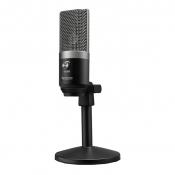

SAMSON Q1U ADAPTER TV
Another way to do this is to hold the mic close to your lips, as you've seen many a TV news reporter do. Many folks use lapel mics that clip to their clothing, putting it very close to the mouth. If your video camera has an external microphone input jack, you can plug a microphone into that. So the solution is to get the mic close to your mouth. This makes the voice sound more immediate and clear. The reason for the latter is that the closer a mic is to your mouth (in most cases), the less of the ambient sound the microphone picks up. If you can somehow close the distance between your mouth and the microphone, you can hugely improve or even eliminate two of the problems I mentioned: the far-away sound and the poor acoustics sound.

Better sound for video: The solution for two of the root-causes If you toss in a common 3rd element to most videos, the fact that the recording room or other space is not acoustically ideal, then you have a recipe for poor video sound. Combine that with the fact that a lot of web video is shot with camcorders, or even mobile devices now, using only the built-in mics, which are usually not designed for great audio. The primary cause of poor audio on talking-head videos is that there is too much distance between the speaker and the microphone.

But any video where people are talking on-screen suffer the same problem and of course, have the same solution. That's where the moniker "talking head" comes from. Typically this is a person talking directly to the camera with usually only their head and shoulders being visible. Let's talk about one particular kind of video - the talking-head video, meaning videos where someone is talking on-screen. Sadly, as many as half of these videos may look great, but they sound terrible. There are a lot of great-looking videos out there all over the web. I'm not sure what this all is, but maybe it will help. Snd_page_alloc 7076 2 snd_hda_intel,snd_pcm Snd 54180 18 snd_hda_codec_idt,snd_hda_intel,snd_hda_codec,snd_ hwdep,snd_pcm_oss,snd_mixer_oss,snd_pcm,snd_seq_os s,snd_rawmidi,snd_seq,snd_timer,snd_seq_device Snd_seq_device 5700 5 snd_seq_dummy,snd_seq_oss,snd_seq_midi,snd_rawmidi ,snd_seq Snd_seq 47263 6 snd_seq_dummy,snd_seq_oss,snd_seq_midi,snd_seq_mid i_event Snd_seq_midi_event 6003 2 snd_seq_oss,snd_seq_midi Snd_pcm 70694 3 snd_hda_intel,snd_hda_codec,snd_pcm_oss Snd_hda_codec 74201 2 snd_hda_codec_idt,snd_hda_intel
SAMSON Q1U ADAPTER UPGRADE
I was using the microphone fine a couple years ago with audacity, I think I was on Hardy Heron at the time (not that the upgrade to lucid was necessarily was what did it.) I haven't changed any hardware since then besides adding a little additional ram. I would really appreciate any suggestions? The microphone is not showing up on either. When I plug it in the light on the microphone goes on for about 10 seconds then goes off.īus 005 Device 001: ID 1d6b:0001 Linux Foundation 1.1 root hubīus 004 Device 001: ID 1d6b:0001 Linux Foundation 1.1 root hubīus 003 Device 001: ID 1d6b:0001 Linux Foundation 1.1 root hubīus 002 Device 001: ID 1d6b:0001 Linux Foundation 1.1 root hubīus 001 Device 001: ID 1d6b:0002 Linux Foundation 2.0 root hub I can use a usb mouse on the usb port, so I think the port works and the microphone worked on my friends PC, so the mic is fine. Unfortunatly, the microphone isn't registering on my computer. I've got a Samson Q1U usb microphone I want to use in Audacity for recording.


 0 kommentar(er)
0 kommentar(er)
